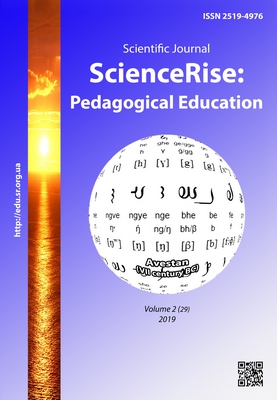The process of formation of communicative-speaking competence of social workers based on the system-target approach
DOI:
https://doi.org/10.15587/2519-4984.2019.161564Keywords:
communicative and speaking competence, system-target approach, elective course, language barriersAbstract
The article deals with theoretical analysis of the literature on determining the place and role of the system-target approach in the process of formation of the communicative-speaking competence of future social workers in higher education institutions. It is indicated, that the usage of a system-target approach is aimed at forming in students a system of interdisciplinary knowledge from linguistic disciplines, communicative skills and skillful usage of them in future professional activities.
The program of the elective course "Technologies of professional communication" was developed. The informative content of which predicted creation of a system of theoretical and methodological knowledge in students about the essence of communicative-speaking activity; the development of skills of professional-speaking communication; performance of practical tasks; communicative exercises (trainings); value attitudes; communicatively significant personal qualities; professional motives, interests, interpersonal interactions. The selection of exercises and tasks was carried out according to the following criteria: purpose; sequence and technique of the intended actions; self-control over the course and results of actions; control over the implementation of exercises and its results from the teacher. Exercise was aimed at practical mastering of the procedure and "technology" of communication on the basis of working out its most important elements, which promoted the development of communicative-speaking skills, acquisition of skills of management in the communication process, ensured the formation of organic and consistent actions in the public environment, technology and speech logic, its expressiveness and emotionality.
Among the conditions that will ensure the effectiveness of educational activities at each stages of the communicative-speaking competence formation there were chosen: the creation of educational communication environment on the basis of a structural and target approach, oriented on compliance with the algorithm of action (analysis, planning, designing); realization of interdisciplinary connections of cycles of psychological and pedagogical, fundamental and professionally oriented disciplines; creating a supportive environment for communication, based on a human, tolerant attitude towards the interlocutor
References
- Romanyshyn, O. Ya. (2016). Metodolohichni pidkhody formuvannia profesiinoi identychnosti maibutnikh uchyteliv zasobamy informatsiinykh tekhnolohii [The methodological approaches to formation of professional identity of future teachers by means of information technologies]. Naukovyi Visnyk Uzhhorodskoho universytetu. Seriia: «Pedahohika. Sotsialna robota», 2 (39), 210–213.
- Kharchenko, S. Ya. (Ed.) (2016). Systemnyi pidkhid u suchasnykh pedahohichnykh doslidzhenniakh v Ukraini [The system approach in modern pedagogical researches in Ukraine]. Starobilsk: Vyd-vo DZ «LNU imeni Tarasa Shevchenka», 495.
- Kichuk, N. V. (2014). Formation of professional orientation of future social pedagogues: some methodological guidelines. Naukovi pratsi Chornomorskoho derzhavnoho universytetu imeni Petra Mohyly kompleksu "Kyievo-Mohylianska akademiia". Seriia: Pedahohika, 251 (239), 62–65. Available at: http://pednauki.chdu.edu.ua/article/view/44436 Last accessed: 10.03.2019
- Shabanova, Yu. O. (2014). Systemnyi pidkhid u vyshchii shkoli [The system approach in high school]. Dnipropetrovsk: NHU, 120.
- Merriam-Webster's Collegiate Dictionary (2014). Merriam-Webster Inc, 1663. Available at: http://books.google.com.ua/books?id=TAnheeIPcAEC&pg=PA 1112&redir_esc Last accessed: 20.03.2019
- Karaman, O. (2012). Systemnyi pidkhid yak metodolohiia doslidzhennia sotsialno-pedahohichnoi roboty z nepovnolitnimy zasudzhenymy v Ukraini [The system approach as a methodology for researching of social working with juvenile convicts in Ukraine]. Naukovi zapysky. Seriia: Pedahohichni nauky, 107_1, 222–229.
- Karpanina, E. N., Gura, A. Yu., Ron, I. N. (2018). Rationale of the System Approach to Education of Future Specialists in the University. Astra Salvensis – revista de istorie si cultura, VI (1), 763–765. Available at: https://www.ceeol.com/search/article-detail?id=647692
- Malafiik, I. V. (2004). Systemnyi pidkhid u teorii i praktytsi [The system approach in theory and practice]. Rivne: Rivnenskyi derzh. hum. un-t, 437.
- Fomitska, N. V. (2014). The specific of applying of the system approach in public administration. Derzhavne budivnytstvo, 2. Available at: http://nbuv.gov.ua/UJRN/DeBu_2014_2_7 Last accessed: 19.03.2018
- Gupta, S., Gupta, A. (2013). The Systems Approach in Education. International Journal of Management, 1 (1), 52–53. Available at: https://www.mitpublications.org/yellow_images/1388230198_logo_paper%207.pdf
- Hlikman, S. (2018). Model of functioning of professional qualities of future navigators in the process of special training. ScienceRise: Pedagogical Education, 5 (25), 9–13. doi: http://doi.org/10.15587/2519-4984.2018.134694
Downloads
Published
How to Cite
Issue
Section
License
Copyright (c) 2019 Liudmyla Berezovska

This work is licensed under a Creative Commons Attribution 4.0 International License.
Our journal abides by the Creative Commons CC BY copyright rights and permissions for open access journals.
Authors, who are published in this journal, agree to the following conditions:
1. The authors reserve the right to authorship of the work and pass the first publication right of this work to the journal under the terms of a Creative Commons CC BY, which allows others to freely distribute the published research with the obligatory reference to the authors of the original work and the first publication of the work in this journal.
2. The authors have the right to conclude separate supplement agreements that relate to non-exclusive work distribution in the form in which it has been published by the journal (for example, to upload the work to the online storage of the journal or publish it as part of a monograph), provided that the reference to the first publication of the work in this journal is included.








